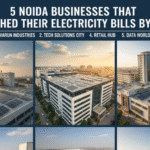Thinking about going solar in 2025? One of the first questions you’ll face is: monocrystalline or polycrystalline solar panels?
This guide explains the difference in simple terms, so you know exactly what’s right for your rooftop, your budget, and your long-term savings.
Whether you’re planning a solar installation in Delhi, Gurugram, Faridabad, Noida, or any part of India, this updated 2025 comparison will help you make the right decision.
What Are Monocrystalline Solar Panels?
Monocrystalline solar panels are made from a single continuous crystal structure of silicon, giving them a solid black appearance and higher performance in most conditions.
Key Features:
- Efficiency: 18% to 22%
- Appearance: Solid black
- Lifespan: 25+ years
- Temperature Performance: High performance in heat and low light
- Space Requirement: Less space for the same power output
Best suited for: Homes and commercial spaces with limited rooftop area, or users looking for long-term performance and better ROI.
What Are Polycrystalline Solar Panels?
Polycrystalline panels are made from multiple fragments of silicon melted together. These panels have a blue, speckled appearance and are generally more budget-friendly.
Key Features:
- Efficiency: 15% to 17%
- Appearance: Blue, slightly speckled
- Lifespan: 20–25 years
- Temperature Performance: Slightly lower than monocrystalline
- Space Requirement: Requires more rooftop area
Best suited for: Larger rooftops and users prioritizing initial cost savings over long-term efficiency.
Monocrystalline vs Polycrystalline: Side-by-Side Comparison
| Feature | Monocrystalline | Polycrystalline |
| Efficiency | 18–22% | 15–17% |
| Appearance | Sleek black | Blue speckled |
| Cost per kW | ₹42,000–₹55,000 | ₹35,000–₹45,000 |
| Space Needed | Less | More |
| Performance in Heat | Better | Moderate |
| Lifespan | 25+ years | 20–25 years |
| Ideal for | Limited space, high output | Large rooftops, budget installs |
Cost Comparison in 2025 (Delhi NCR)
In Delhi NCR, solar panel prices vary depending on panel type, brand, installer, and system size:
- Monocrystalline system (3kW–10kW): ₹42,000–₹55,000 per kW
- Polycrystalline system (3kW–10kW): ₹35,000–₹45,000 per kW
For a detailed price guide, read: Cost of Solar Panel Installation in India
Which One Should You Choose in 2025?
Choose Monocrystalline If:
- You have limited rooftop space
- You want high energy output and long-term savings
- You prefer a modern and premium look
- Your area has partial shade or low sunlight
Choose Polycrystalline If:
- You want to keep upfront costs low
- You have ample rooftop space
- Your energy consumption is moderate
- You’re looking for a good balance of cost and performance
Real-World Considerations for Indian Homes
- Climate: Monocrystalline performs better in high-heat zones like Delhi NCR and Rajasthan.
- Rooftop Space: Polycrystalline requires more panels for the same output.
- Subsidy Eligibility: Both types are eligible under solar subsidies in India.
Also explore:
Not Sure Which Panel to Choose?
Let our expert team guide you. We’ve helped hundreds of families and businesses across Delhi NCR choose the right solar system based on space, budget, and performance goals.
Book a free rooftop solar consultation
Request your free assessment now →
Related Articles to Explore
- How to Maximize Solar Panel Efficiency with Proper Maintenance
- On-Grid vs Off-Grid vs Hybrid Solar Systems
- Solar Subsidies in India – Updated for 2025
- Top Solar Panel Companies in Delhi NCR – 2025 Guide
Frequently Asked Questions
Q1. Which is better: monocrystalline or polycrystalline?
Monocrystalline panels are more efficient and space-saving, while polycrystalline panels are more affordable. Your choice depends on rooftop size, budget, and energy goals.
Q2. How long do solar panels last in India?
Monocrystalline panels can last over 25 years, while polycrystalline panels usually last 20–25 years with proper maintenance.
Q3. Do monocrystalline panels perform better in Indian weather?
Yes. Their higher efficiency and better performance under heat make them ideal for India’s climate, especially in cities like Delhi, Gurugram, and Faridabad.
Q4. Are both types eligible for solar subsidies in India?
Yes, both panel types are eligible under the rooftop solar subsidy scheme provided by the MNRE.






